Localizing SDG 11.6.2 via Earth Observation, Modelling Applications, and Harmonised City Definitions: Policy Implications on Addressing Air Pollution
Abstract
1. Introduction: Policy State-of-Play
2. Methodology
2.1. Defining SDG Indicator 11.6.2 and City Definitions
2.2. SMURBS Estimation of SDG 11.6.2 at the Country and City Level across Europe
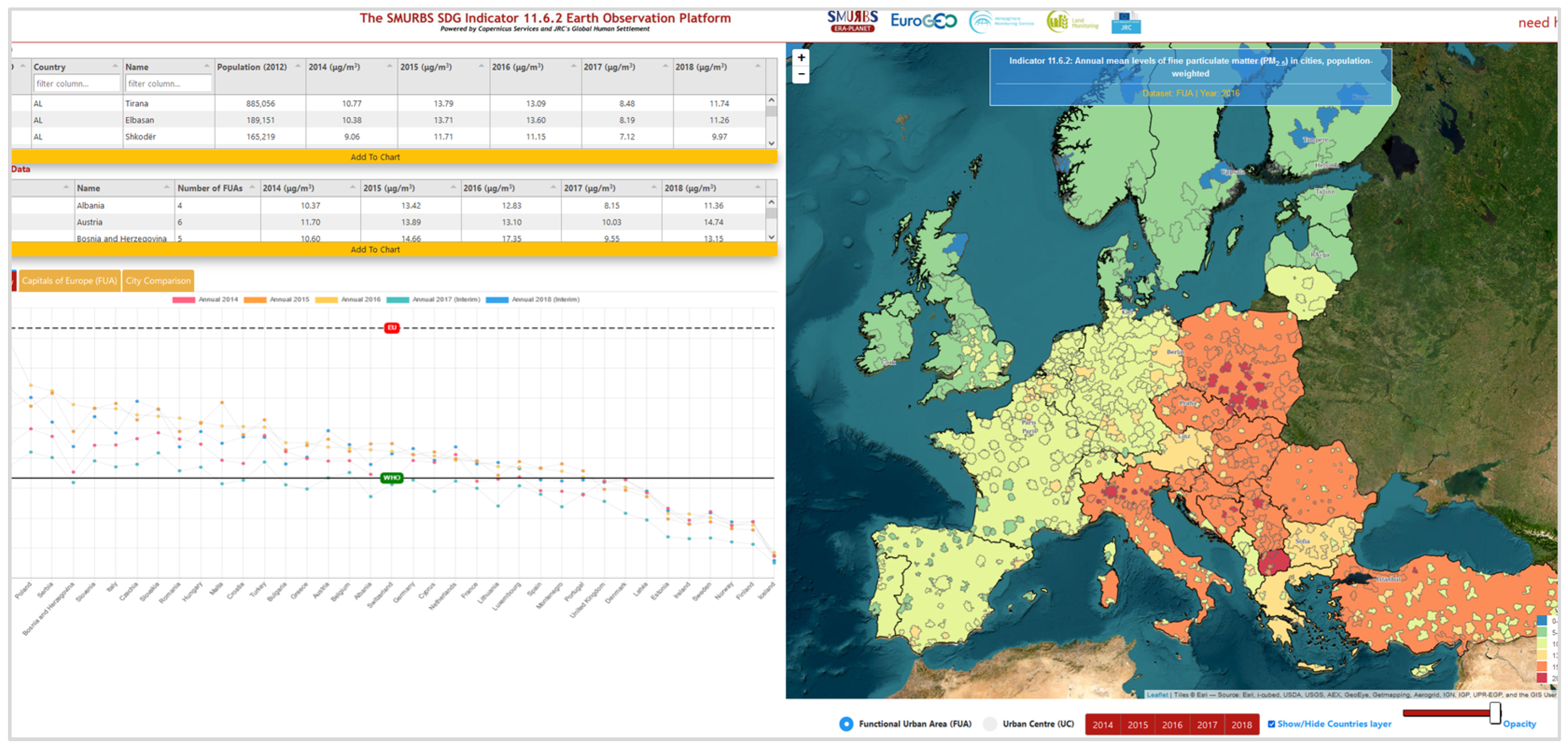
2.2.1. Copernicus Services, Data Provision, and Processing
2.2.2. Qualitative Comparisons with Data from Existing Efforts
2.3. Intra-Urban Scale Adaptations of SDG Indicator 11.6.2

2.3.1. City-Scale Air Quality Modelling
2.3.2. Intra-Urban Scale via the Administrative and Gridded Approaches
3. Results
3.1. Country-Level Comparisons
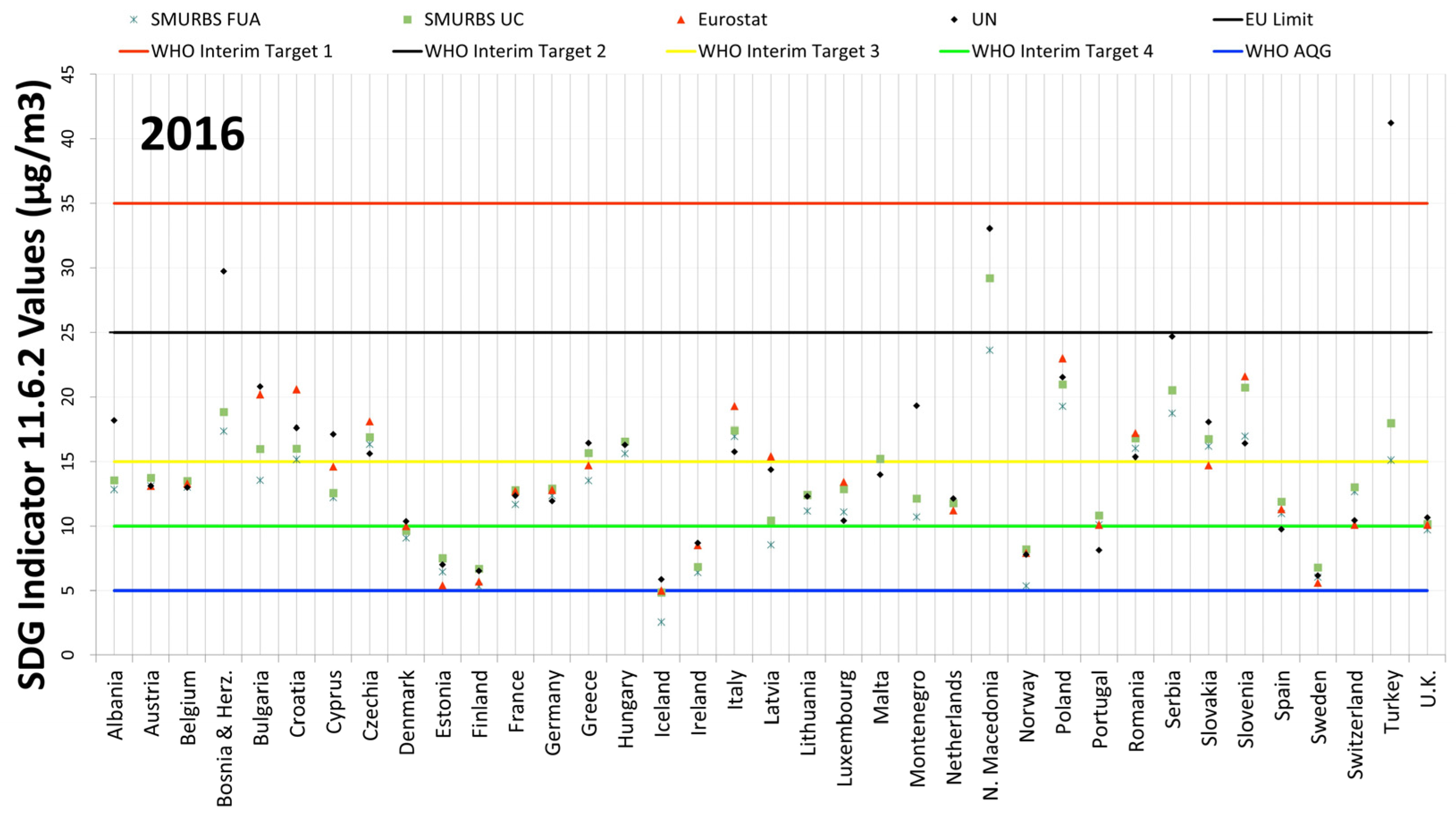
3.2. City-Level Comparisons
3.3. Intra-Urban Scale SDG 11.6.2
3.3.1. PM2.5 Modelling Results for Hamburg
3.3.2. Administrative-Oriented Approach to SDG 11.6.2
- 11.51 µg/m3, based on district-level population and PM2.5 means;
- 11.83 µg/m3, based on neighbourhood-level population and PM2.5 means.
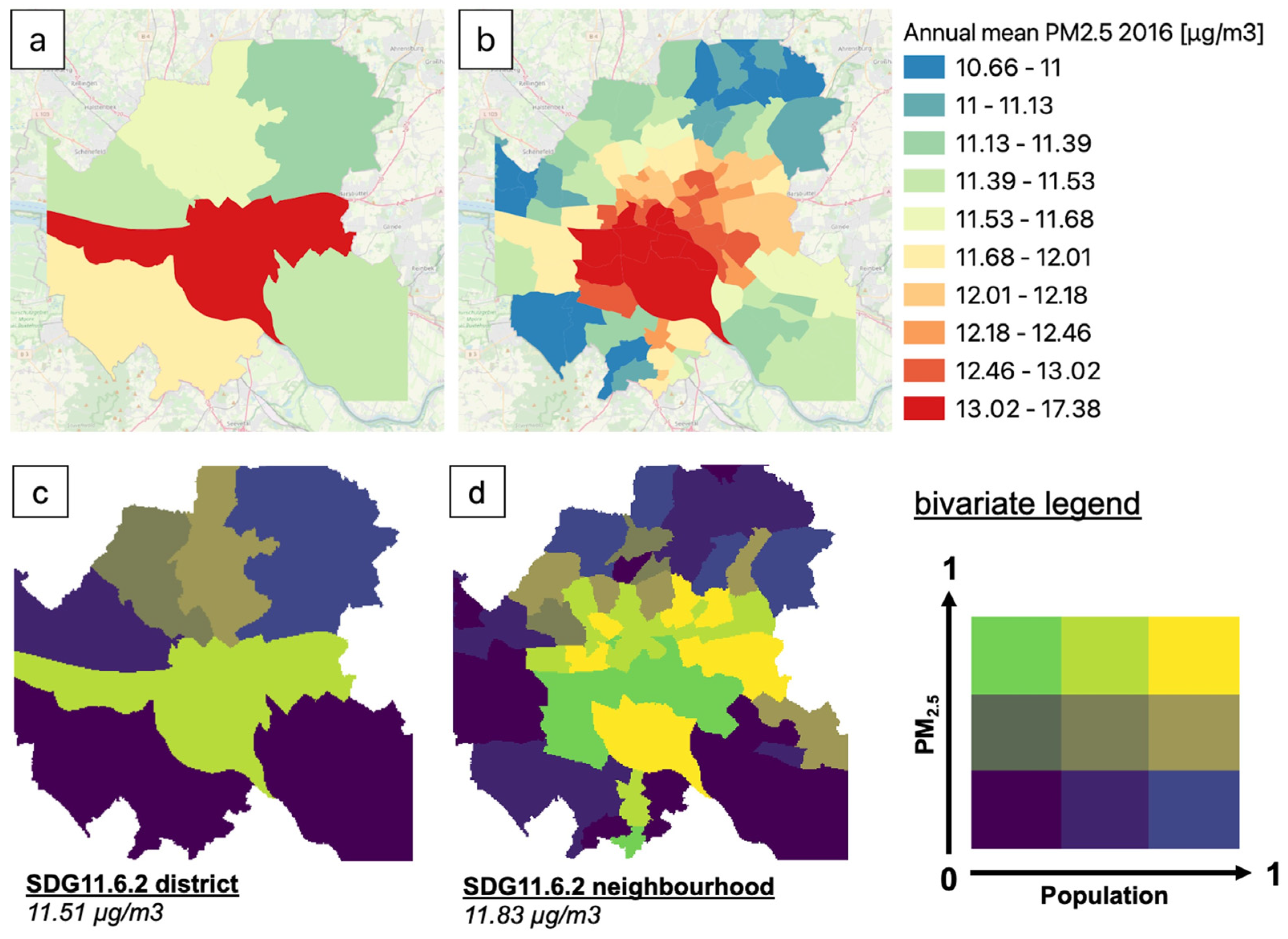
3.3.3. Gridded Approach
4. Discussion and Policy Implications
4.1. Divergent Results with Different Approaches and City Definitions
- Emission inventories, meteorological data, and pollutant boundary conditions: this information, which is necessary for chemistry-transport models, is publicly available for the whole of Europe and many other regions in the world and can be accessed for different years. Since emission inventories are mostly driven by information provided by countries, in regions where there is lack of adequate information or there is an indication of deliberate underestimation of national emissions, then this propagates as an error in the estimation of the indicator values and might be reflected as increased discrepancy between the different available methods.
- In situ air quality data: this is necessary to validate and evaluate a model’s output and, in particular, to ensure good performance, improve or correct the model results, apply offsets, or refine emission inventories. Moreover, the comparison of predictions against measurements helps reveal sources, seasonality, or any type of inconsistencies which should be taken into account in the evaluation of the SDG 11.6.2 Indicator.
- Geospatial information for the extent of the appropriate authority unit: the administrative-oriented approach relies on available spatial definitions (and respective data) for districts, neighbourhoods, or other statistical units, which can be accessed via national, city, or municipality sources, usually via open data platforms.
- Population density: the respective population per unit needs to be known for the calculation of the indicator. In addition, one must not only determine the population, but match it with the corresponding authority unit, which may not always be the same all around the world. Cities that lack such information may overcome this barrier through the gridded approach, i.e., by combining urban-scale air quality fields with publicly available UN datasets. The 2021 EU-wide population and housing census has presented a major innovation along the above lines, as key census elements will be delivered on a 1 km square grid, allowing for more flexible exploitation, and facilitating tailored research and accomplishment of policy needs (such as the SDGs’ frame).
- 18% higher, compared to the district-approach value (11.51 μg/m3);
- 15% higher, compared to the neighbourhood-approach value (11.83 μg/m3);
- 12% higher, compared to the gridded-approach value (12.33 μg/m3).
4.2. Disaggregating SDG 11.6.2 and Enabling Local Action
4.3. Policy and Future Proofing
5. Conclusions
Author Contributions
Funding
Data Availability Statement
Acknowledgments
Conflicts of Interest
Appendix A
Appendix A.1. Geographical Map of Studied Cities
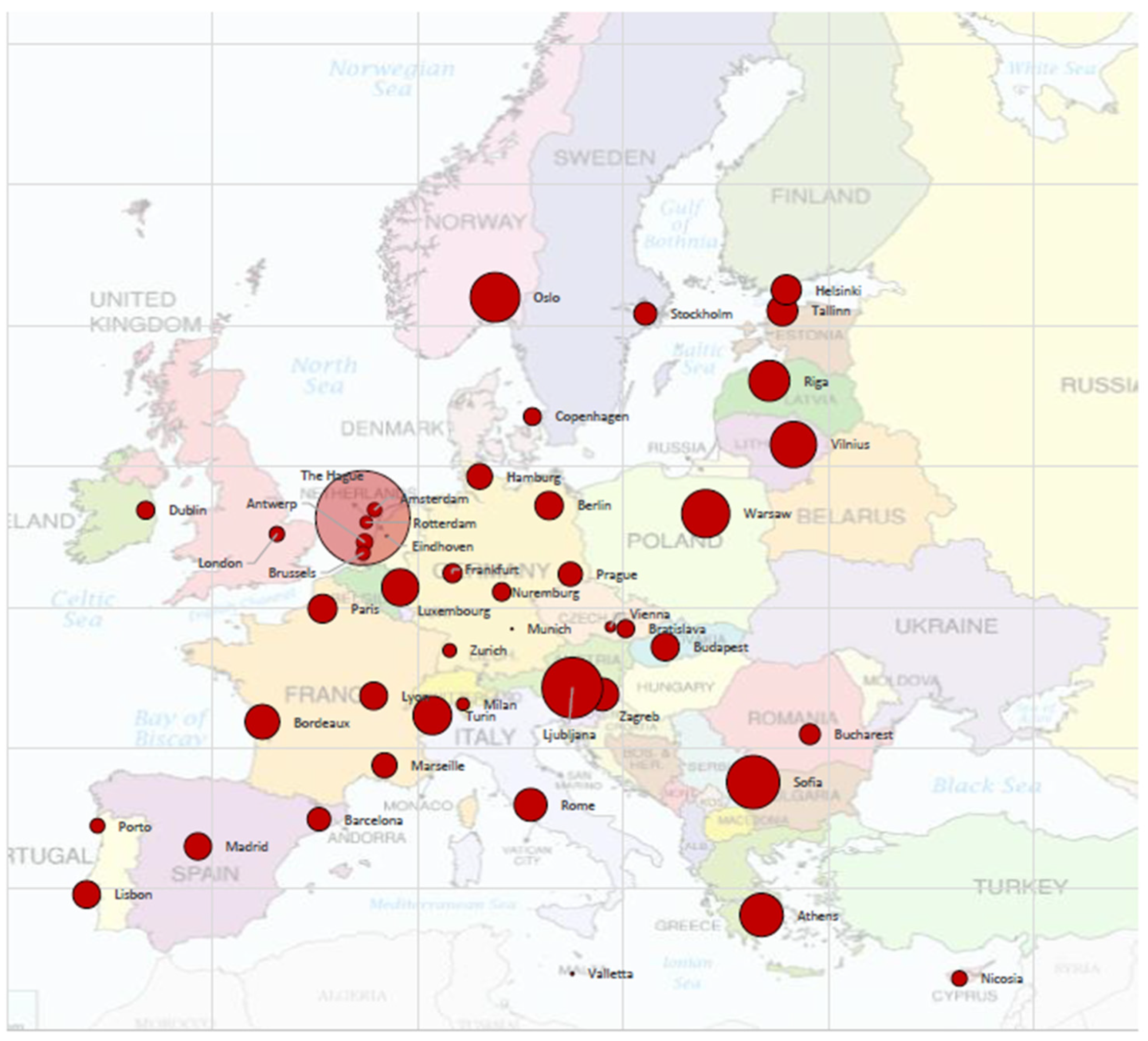
Appendix A.2. Overview of EPISODE-CityChem Setup
| CTM Setup with EPISODE-CityChem | Setup for Hamburg 2016 |
|---|---|
| Horizontal domain size (x × y) | 30 × 30 km2 (30,000 × 30,000 m2) |
| Horizontal domain resolution | 100 m |
| Model grid coordinate system | WGS1984 Universal Transverse Mercator (UTM) Zone 32N |
| Vertical dimension | Lowest layer height 17.5 m, 16 vertical layers below 1000 m, vertical top height 3750 m |
| Boundary Conditions | Hourly Copernicus Atmospheric Monitoring Services (CAMS) regional ensemble concentrations |
| Meteorology | Hourly meteorological fields simulated with The Air Pollution Model (TAPM), 1000 m horizontal grid resolution |
| Point source emissions * | 750 sources (federal emission reports, 11.BimSchV) |
| Lin source emissions * | 12,625 road links (CAMS-REG-AP v3.1, OSM) |
| Area source emissions * | 6430 sources, grid resolution 1000 m (CAMS-REG-AP v3.1) |
Appendix A.3. Evaluation of CityChem Simulations
| Site | n | FAC2 | MB | NMB | RMSE | r | IOA |
|---|---|---|---|---|---|---|---|
| 13ST (urban) | 352 | 0.81 | −3.03 | −0.23 | 8.39 | 0.51 | 0.60 |
| 20VE (urban background) | 364 | 0.81 | −1.62 | −0.12 | 7.67 | 0.48 | 0.61 |
| 61WB (urban background) | 364 | 0.78 | −1.18 | −0.09 | 9.26 | 0.29 | 0.53 |
| 64KS (road site) | 347 | 0.82 | −2.49 | −0.17 | 7.91 | 0.51 | 0.60 |
| 68HB (road site) | 363 | 0.88 | −2.27 | −0.14 | 8.29 | 0.52 | 0.62 |
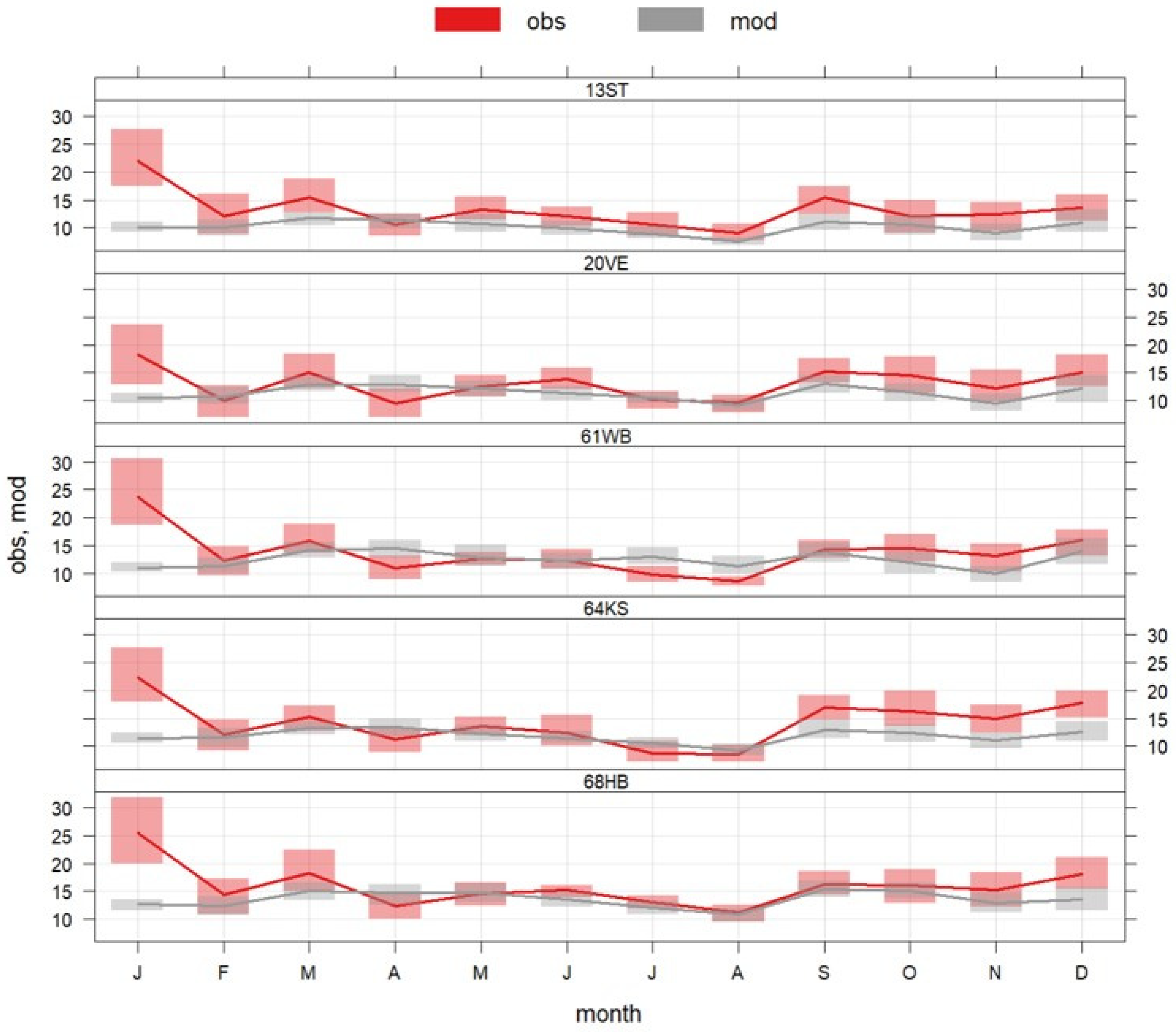
References
- World Health Organization. WHO Global Air Quality Guidelines. Particulate Matter (PM2.5 and PM10), Ozone, Nitrogen Dioxide, Sulfur Dioxide and Carbon Monoxide; World Health Organization: Geneva, Switzerland, 2021.
- Europe’s Air Quality Status 2021—European Environment Agency. Briefing No. 08/2021. Available online: https://www.eea.europa.eu/publications/air-quality-status-2021 (accessed on 28 December 2022).
- Air Quality Standards—European Environment Agency. Available online: https://www.eea.europa.eu/themes/air/air-quality-concentrations/air-quality-standards (accessed on 28 December 2022).
- Air Pollution: How It Affects Our Health—European Environment Agency. Available online: https://www.eea.europa.eu/themes/air/health-impacts-of-air-pollution (accessed on 28 December 2022).
- Air Quality—Revision of EU Rules. Available online: https://ec.europa.eu/info/law/better-regulation/have-your-say/initiatives/12677-Revision-of-EU-Ambient-Air-Quality-legislation/public-consultation_en (accessed on 28 December 2022).
- Health Impacts of Air Pollution in Europe. 2021. Available online: https://www.eea.europa.eu/publications/air-quality-in-europe-2021/health-impacts-of-air-pollution (accessed on 28 December 2022).
- SDG Indicators Metadata Repository. Available online: https://unstats.un.org/sdgs/metadata/?Text=&Goal=&Target=11.6 (accessed on 28 December 2022).
- Shaddick, G.; Thomas, M.L.; Jobling, A.; Brauer, M.; van Donkelaar, A.; Burnett, R.; Chang, H.; Cohen, A.; Van Dingenen, R.; Dora, C.; et al. Data Integration Model for Air Quality: A Hierarchical Approach to the Global Estimation of Exposures to Ambient Air Pollution. arXiv 2016, arXiv:1609.00141. [Google Scholar] [CrossRef]
- Lafortune, G.; Fuller, G.; Bermont Diaz, L.; Kloke-Lesch, A.; Koundouri, P.; Riccaboni, A. Achieving the SDGs: Europe’s Compass in a Multipolar World. In Europe Sustainable Development Report 2022; SDSN and SDSN Europe: Paris, France, 2022. [Google Scholar]
- ‘Our Struggle for Global Sustainability Will Be Won or Lost in Cities’, Says Secretary-General, at New York Event | UN Press. Available online: https://press.un.org/en/2012/sgsm14249.doc.htm (accessed on 28 December 2022).
- Lafortune, G.; Zoeteman, K.; Fuller, G.; Mulder, R.; Dagevos, J.; Schmidt-Traub, G. The 2019 SDG Index and Dashboards Report for European Cities (Prototype Version). Sustainable Development Solutions Network (SDSN) and the Brabant Center for Sustainable Development (Telos). 2019. Available online: https://www.sdgindex.org/reports/sdg-index-and-dashboards-report-for-european-cities/ (accessed on 28 December 2022).
- European Commission. Directorate-General for Communication, Towards a Sustainable Europe by 2030: Reflection Paper; Publications Office: Luxembourg, 2019. [CrossRef]
- Siragusa, A.; Vizcaino, P.; Proietti, P.; Lavalle, C. European Handbook for SDG Voluntary Local Reviews; Publications Office of the European Union: Luxembourg, 2020; ISBN 9789276154037.
- ITU-T Y.4900 Series—Key Performance Indicators Definitions for Smart Sustainable Cities; Series Y; Telecommunication Standardization Sector of ITU. 2016. Available online: https://www.itu.int/rec/T-REC-Y.Sup39-201510-I/en (accessed on 28 December 2022).
- Klopp, J.M.; Petretta, D.L. The Urban Sustainable Development Goal: Indicators, Complexity and the Politics of Measuring Cities. Cities 2017, 63, 92–97. [Google Scholar] [CrossRef]
- Gerasopoulos, E.; Bailey, J.; Athanasopoulou, E.; Speyer, O.; Kocman, D.; Raudner, A.; Tsouni, A.; Kontoes, H.; Johansson, C.; Georgiadis, C.; et al. Earth Observation: An Integral Part of a Smart and Sustainable City. Environ. Sci. Policy 2022, 132, 296–307. [Google Scholar] [CrossRef]
- Kavvada, A.; Friedl, L.; Ramage, S. Tools to Enable UN Member States at National and Local Level to Use Earth Observations to Help Deliver the UN SDG. In Proceedings of the International Astronautical Congress, IAC; International Astronautical Federation, IAF: Paris, France, 12–14 October 2020. [Google Scholar]
- Dacey, J. Using Big Data to Measure Environmental Inclusivity in Cities. Available online: http://eos.org/articles/using-big-data-to-measure-environmental-inclusivity-in-cities (accessed on 29 December 2022).
- Hsu, A.; Chakraborty, T.; Thomas, R.; Manya, D.; Weinfurter, A.; Chin, N.J.W.; Goyal, N.; Feierman, A. Measuring What Matters, Where It Matters: A Spatially Explicit Urban Environment and Social Inclusion Index for the Sustainable Development Goals. Front. Sustain. Cities 2020, 2, 556484. [Google Scholar] [CrossRef]
- Ulbrich, P.; Porto de Albuquerque, J.; Coaffee, J. The Impact of Urban Inequalities on Monitoring Progress towards the Sustainable Development Goals: Methodological Considerations. ISPRS Int. J. Geo-Inf. 2019, 8, 6. [Google Scholar] [CrossRef]
- Wilson, J.G.; Kingham, S.; Pearce, J.; Sturman, A.P. A Review of Intraurban Variations in Particulate Air Pollution: Implications for Epidemiological Research. Atmos. Environ. 2005, 39, 6444–6462. [Google Scholar] [CrossRef]
- Samoli, E.; Stergiopoulou, A.; Santana, P.; Rodopoulou, S.; Mitsakou, C.; Dimitroulopoulou, C.; Bauwelinck, M.; de Hoogh, K.; Costa, C.; Marí-Dell’Olmo, M.; et al. Spatial Variability in Air Pollution Exposure in Relation to Socioeconomic Indicators in Nine European Metropolitan Areas: A Study on Environmental Inequality. Environ. Pollut. 2019, 249, 345–353. [Google Scholar] [CrossRef]
- European Commission; Joint Research Centre. Urban PM2.5 Atlas: Air Quality in European Cities; Publications Office: Luxembourg, 2017. [CrossRef]
- Shaddick, G.; Salter, J.M.; Peuch, V.-H.; Ruggeri, G.; Thomas, M.L.; Mudu, P.; Tarasova, O.; Baklanov, A.; Gumy, S. Global Air Quality: An Inter-Disciplinary Approach to Exposure Assessment for Burden of Disease Analyses. Atmosphere 2021, 12, 48. [Google Scholar] [CrossRef]
- Global City and Settlement Definition. Available online: https://ec.europa.eu/eurostat/cros/content/global-city-and-settlement-definition_en (accessed on 29 December 2022).
- UN Economic and Social Council. Implementation of the 2020 World Population and Housing Census Programme and the Methodology for Delineation of Cities and Urban and Rural Areas for International Comparison Purposes: Report of the Secretary-General; UN Economic and Social Council: New York, NY, USA, 3 March 2020.
- Applying the Degree of Urbanisation—A Methodological Manual to Define Cities, Towns and Rural Areas for International Comparisons—2021 Edition. Available online: https://ec.europa.eu/eurostat/web/products-manuals-and-guidelines/-/ks-02-20-499 (accessed on 29 December 2022).
- Airaghi, D.; Corbane, C.; Ehrlich, D.; Florczyk, A.J.; Freire, S.; Kemper, T.; Maffenini, M.; Melchiorri, M.; Pesaresi, M.; Politis, P. Description of the GHS Urban Centre Database 2015: Public Release 2019: Version 1.0; Publications Office of the European Union: Luxembourg, 2019; ISBN 9789279997532.
- Dijkstra, L.; Poelman, H.; Veneri, P. The EU-OECD Definition of a Functional Urban Area; OECD Publishing: Paris, France, 2019. [Google Scholar] [CrossRef]
- United Nations General Assembly. Resolution Adopted by the General Assembly on 25 September 2015. In Proceedings of the Agenda Items 15 and 116, New York, NY, USA, 25 September 2015. [Google Scholar]
- New Urban Agenda: H III: Habitat III: Quito 17-20 October 2016; United Nations: Nairobi, Kenya, 2017; ISBN 9789211327311.
- Eurostat. Exposure to Air Pollution by Particulate Matter (Source: EEA) (Sdg_11_50). Available online: https://ec.europa.eu/eurostat/cache/metadata/en/sdg_11_50_esmsip2.htm (accessed on 29 December 2022).
- European Environment Agency Concept: Agglomeration in the Zonetype Vocabulary. Available online: http://dd.eionet.europa.eu/vocabularyconcept/aq/zonetype/agg/view (accessed on 29 December 2022).
- National Observatory of Athens. The SMURBS SDG Indicator 11.6.2 Earth Observation Platform. Available online: http://apcg.meteo.noa.gr/sdg1162/ (accessed on 29 December 2022).
- Group on Earth Observations. Available online: https://www.earthobservations.org/index.php (accessed on 29 December 2022).
- Urban Atlas 2012—Copernicus Land Monitoring Service. Available online: https://land.copernicus.eu/local/urban-atlas/urban-atlas-2012 (accessed on 29 December 2022).
- Copernicus Atmospheric Monitoring Service AIR QUALITY in Europe: Ensemble Modelling. Available online: https://www.regional.atmosphere.copernicus.eu/ (accessed on 29 December 2022).
- World Health Organization Air Quality Database 2016. Available online: https://www.who.int/data/gho/data/themes/air-pollution/who-air-quality-database/2016 (accessed on 29 December 2022).
- Bailey, J.; Speyer, O.; Gerasopoulos, E.; Athanasopoulou, E. Insights and Policy Implications from a Harmonized Earth Observation Approach to Urban Air Quality. ESS Open Arch. 2020. [Google Scholar] [CrossRef]
- Karl, M.; Walker, S.-E.; Solberg, S.; Ramacher, M.O.P. The Eulerian Urban Dispersion Model EPISODE—Part 2: Extensions to the Source Dispersion and Photochemistry for EPISODE–CityChem v1.2 and Its Application to the City of Hamburg. Geosci. Model Dev. 2019, 12, 3357–3399. [Google Scholar] [CrossRef]
- Hamer, P.D.; Walker, S.-E.; Sousa-Santos, G.; Vogt, M.; Vo-Thanh, D.; Lopez-Aparicio, S.; Schneider, P.; Ramacher, M.O.P.; Karl, M. The Urban Dispersion Model EPISODE V10.0—Part 1: An Eulerian and Sub-Grid-Scale Air Quality Model and Its Application in Nordic Winter Conditions. Geosci. Model Dev. 2020, 13, 4323–4353. [Google Scholar] [CrossRef]
- Thunis, P.; Pederzoli, A.; Pernigotti, D. Performance Criteria to Evaluate Air Quality Modeling Applications. Atmos. Environ. 2012, 59, 476–482. [Google Scholar] [CrossRef]
- Monteiro, A.; Durka, P.; Flandorfer, C.; Georgieva, E.; Guerreiro, C.; Kushta, J.; Malherbe, L.; Maiheu, B.; Miranda, A.I.; Santos, G.; et al. Strengths and Weaknesses of the FAIRMODE Benchmarking Methodology for the Evaluation of Air Quality Models. Air Qual. Atmos. Health 2018, 11, 373–383. [Google Scholar] [CrossRef]
- Ramacher, M.O.P.; Karl, M. Integrating Modes of Transport in a Dynamic Modelling Approach to Evaluate Population Exposure to Ambient NO2 and PM2.5 Pollution in Urban Areas. Int. J. Environ. Res. Public Health 2020, 17, 2099. [Google Scholar] [CrossRef]
- Ramacher, M.O.P.; Kakouri, A.; Speyer, O.; Feldner, J.; Karl, M.; Timmermans, R.; Denier van der Gon, H.; Kuenen, J.; Gerasopoulos, E.; Athanasopoulou, E. The UrbEm Hybrid Method to Derive High-Resolution Emissions for City-Scale Air Quality Modeling. Atmosphere 2021, 12, 1404. [Google Scholar] [CrossRef]
- Lauenburg, M.; Karl, M.; Matthias, V.; Quante, M.; Ramacher, M.O.P. City Scale Modeling of Ultrafine Particles in Urban Areas with Special Focus on Passenger Ferryboat Emission Impact. Toxics 2022, 10, 3. [Google Scholar] [CrossRef]
- Feldner, J.; Ramacher, M.O.P.; Karl, M.; Quante, M.; Luttkus, M.L. Analysis of the Effect of Abiotic Stressors on BVOC Emissions from Urban Green Infrastructure in Northern Germany. Environ. Sci. Atmos. 2022, 2, 1132–1151. [Google Scholar] [CrossRef]
- Kuenen, J.; Dellaert, S.; Visschedijk, A.; Jalkanen, J.-P.; Super, I.; Denier van der Gon, H. CAMS-REG-v4: A State-of-the-Art High-Resolution European Emission Inventory for Air Quality Modelling. Earth Syst. Sci. Data 2022, 14, 491–515. [Google Scholar] [CrossRef]
- Hersbach, H.; Bell, B.; Berrisford, P.; Hirahara, S.; Horányi, A.; Muñoz-Sabater, J.; Nicolas, J.; Peubey, C.; Radu, R.; Schepers, D.; et al. The ERA5 Global Reanalysis. Q. J. R. Meteorol. Soc. 2020, 146, 1999–2049. [Google Scholar] [CrossRef]
- Hurley, P.J.; Physick, W.L.; Luhar, A.K. TAPM: A Practical Approach to Prognostic Meteorological and Air Pollution Modelling. Environ. Model. Softw. 2005, 20, 737–752. [Google Scholar] [CrossRef]
- Hanna, S.; Chang, J. Acceptance Criteria for Urban Dispersion Model Evaluation. Meteorol. Atmos. Phys. 2012, 116, 133–146. [Google Scholar] [CrossRef]
- Statistisches Amt für Hamburg und Schleswig-Holstein (2019): Statistisches Jahrbuch Hamburg 2018/2019. Hamburg. Available online: https://www.statistik-nord.de/presse-veroeffentlichungen/statistische-jahrbuecher?tx_standocuments_pi1%5B%40widget_0%5D%5BcurrentYear%5D=2019&cHash=0a4081635497e20ad6677f832123d54a (accessed on 2 January 2023).
- Statistisches Amt für Hamburg und Schleswig-Holstein Interaktive Karte Für Hamburg Zum Zensus 2011. Available online: https://www.statistik-nord.de/fileadmin/maps/zensus2011_hh/ (accessed on 2 January 2023).
- Georgiadis, C.; Patias, P.; Verde, N.; Tsioukas, V.; Kaimaris, D.; Georgoula, O.; Kocman, D.; Athanasopoulou, E.; Speyer, O.; Raudner, A.; et al. State-of-Play in Addressing Urban Environmental Pressures: Mind the Gaps. Environ. Sci. Policy 2022, 132, 308–322. [Google Scholar] [CrossRef]
- World Health Organization Air Quality Database (Update 2022). Available online: https://www.who.int/data/gho/data/themes/air-pollution/who-air-quality-database (accessed on 31 December 2022).
- Özkaynak, H.; Baxter, L.K.; Dionisio, K.L.; Burke, J. Air Pollution Exposure Prediction Approaches Used in Air Pollution Epidemiology Studies. J. Expo. Sci. Environ. Epidemiol. 2013, 23, 566–572. [Google Scholar] [CrossRef] [PubMed]
- Soares, J.; Kousa, A.; Kukkonen, J.; Matilainen, L.; Kangas, L.; Kauhaniemi, M.; Riikonen, K.; Jalkanen, J.-P.; Rasila, T.; Hänninen, O.; et al. Refinement of a Model for Evaluating the Population Exposure in an Urban Area. Geosci. Model Dev. 2014, 7, 1855–1872. [Google Scholar] [CrossRef]
- Reis, S.; Liška, T.; Vieno, M.; Carnell, E.J.; Beck, R.; Clemens, T.; Dragosits, U.; Tomlinson, S.J.; Leaver, D.; Heal, M.R. The Influence of Residential and Workday Population Mobility on Exposure to Air Pollution in the UK. Environ. Int. 2018, 121, 803–813. [Google Scholar] [CrossRef]
- Work of the Statistical Commission Pertaining to the 2030 Agenda for Sustainable Development. In Proceedings of the Resolution Adopted by the General Assembly, United Nations General Assembly 71/313, A/RES/71/313, New York, NY, USA, 6 July 2017.
- Shaddick, G.; Thomas, M.L.; Green, A.; Brauer, M.; Donkelaar, A.; Burnett, R.; Chang, H.H.; Cohen, A.; Dingenen, R.V.; Dora, C.; et al. Data Integration Model for Air Quality: A Hierarchical Approach to the Global Estimation of Exposures to Ambient Air Pollution. J. R. Stat. Soc. C 2018, 67, 231–253. [Google Scholar] [CrossRef]
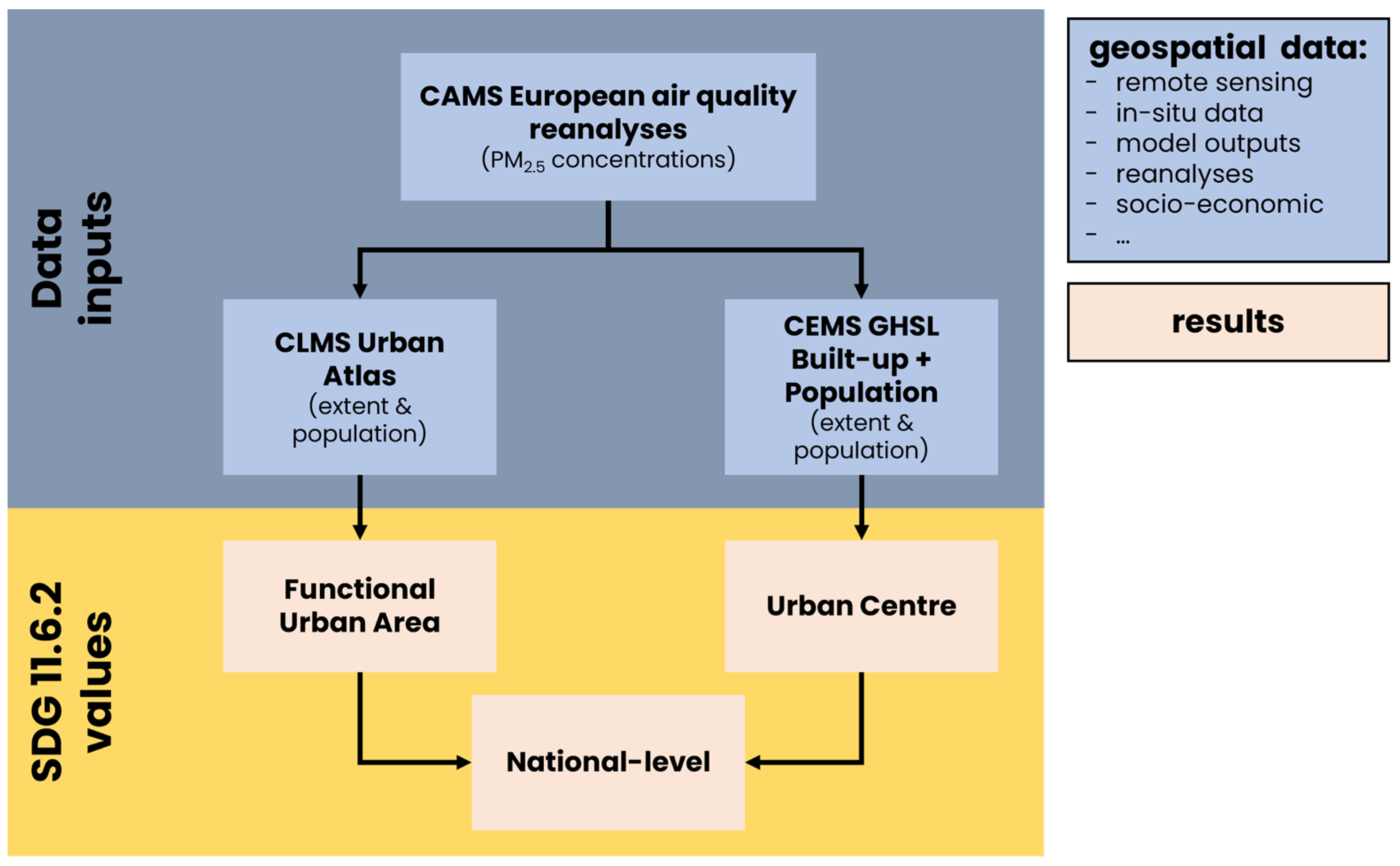
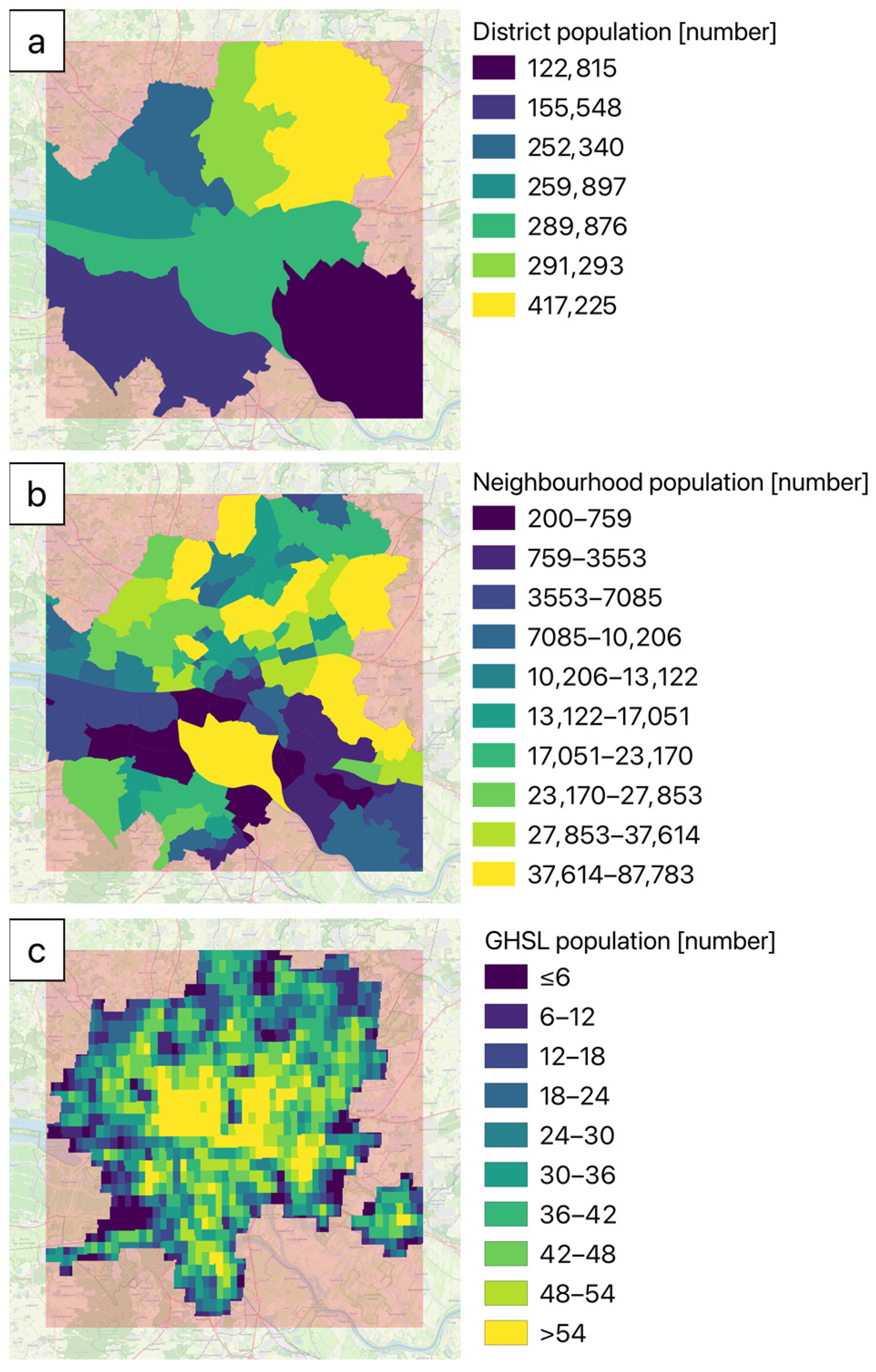
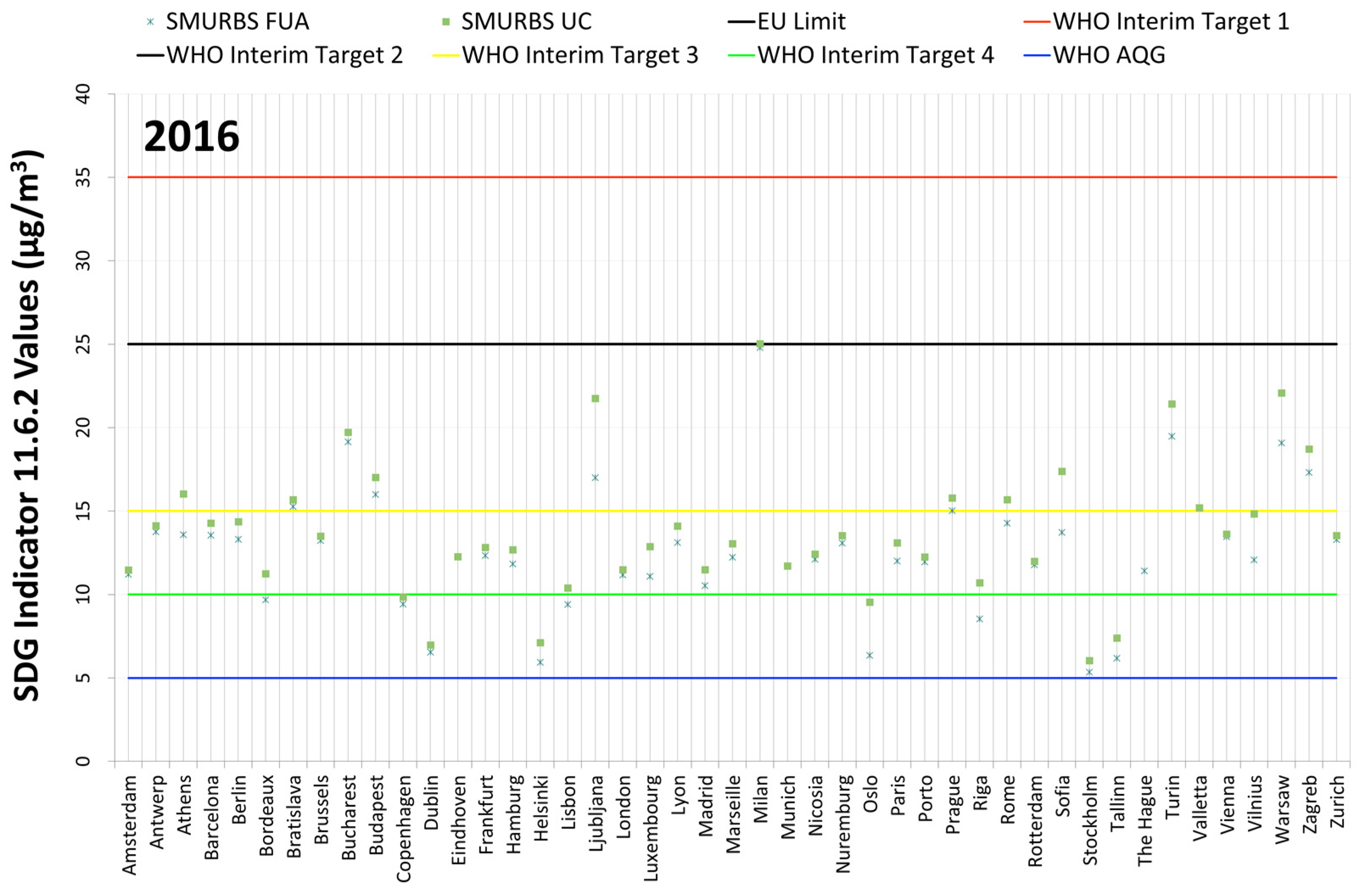
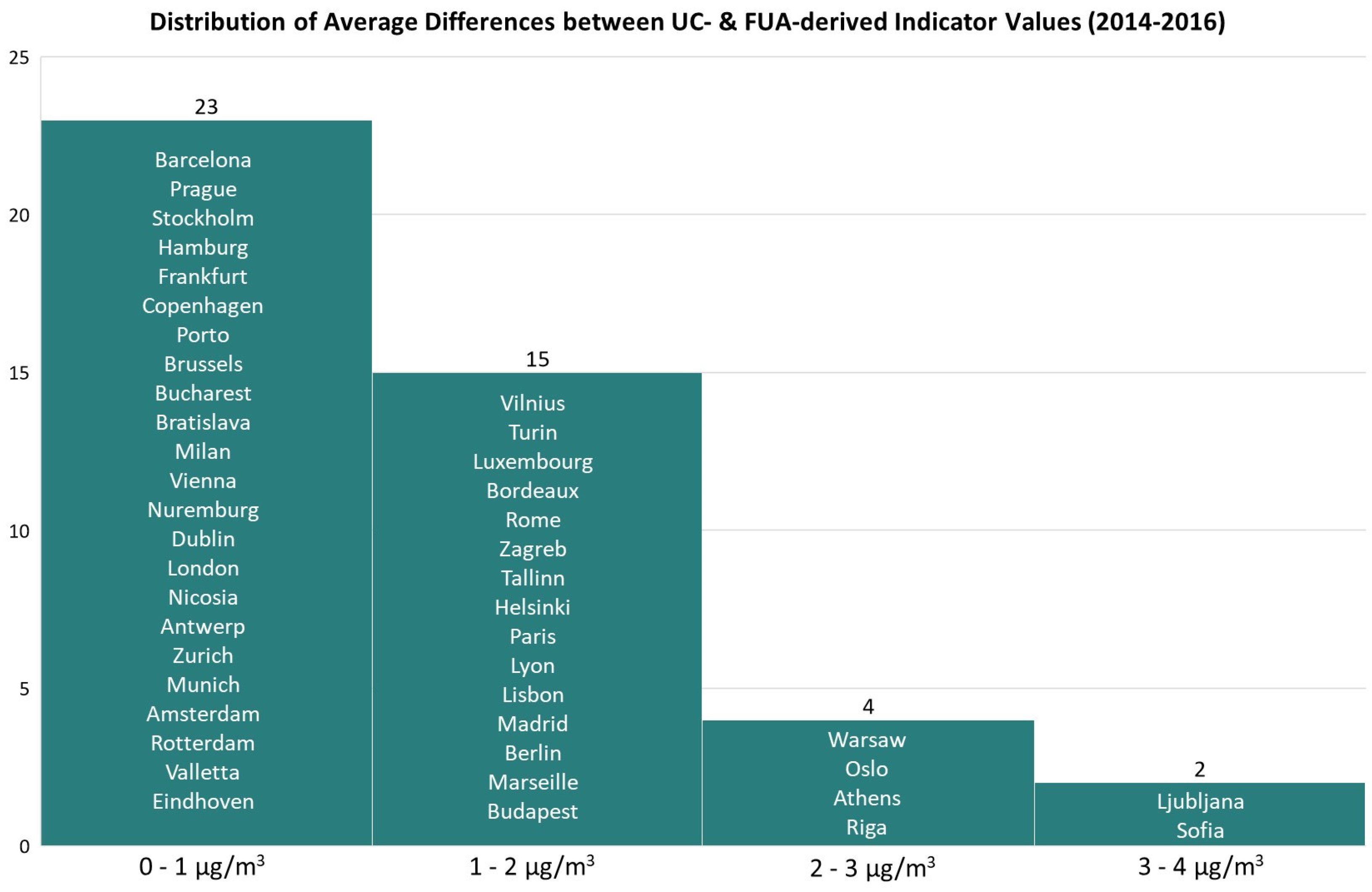
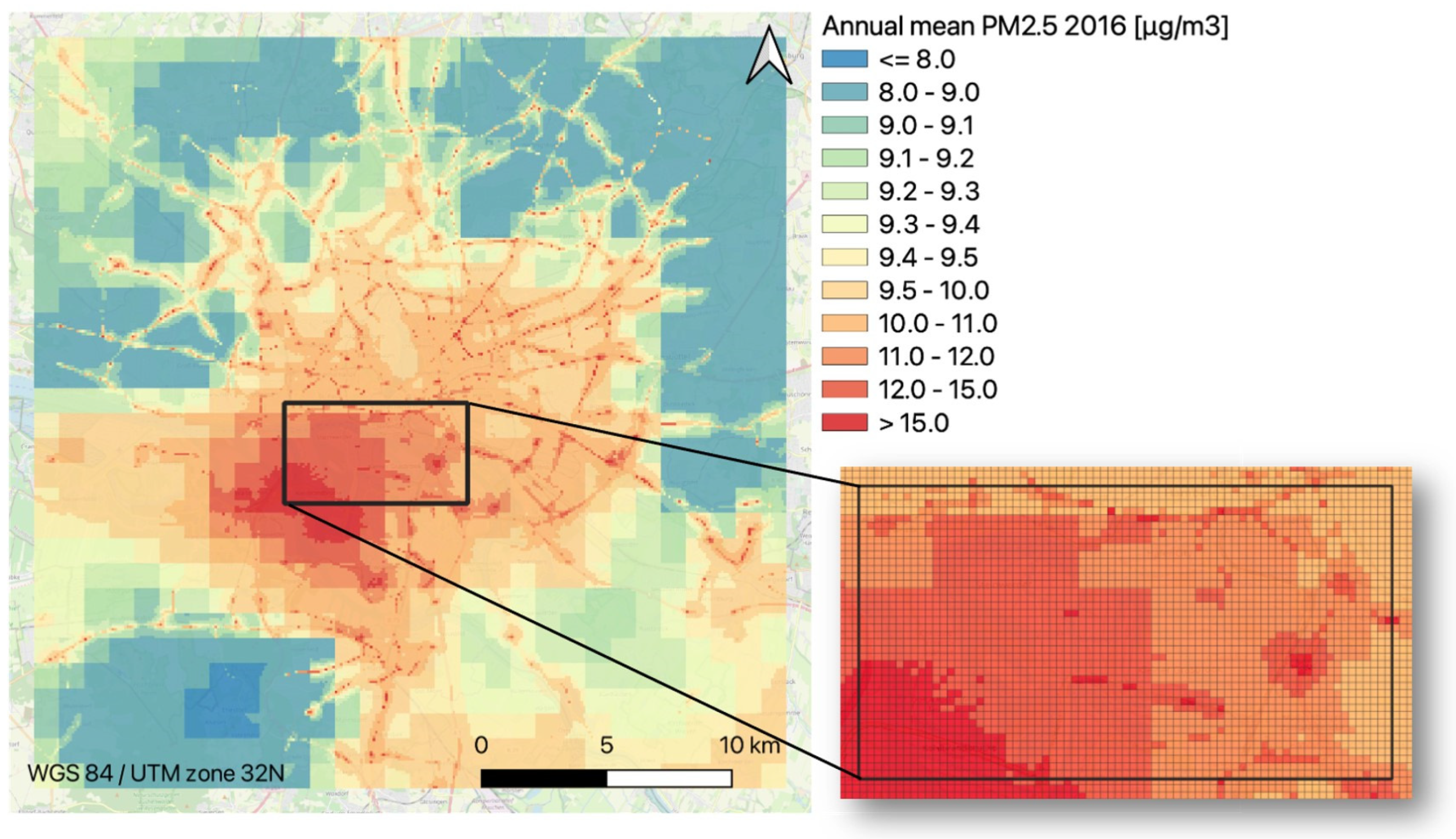
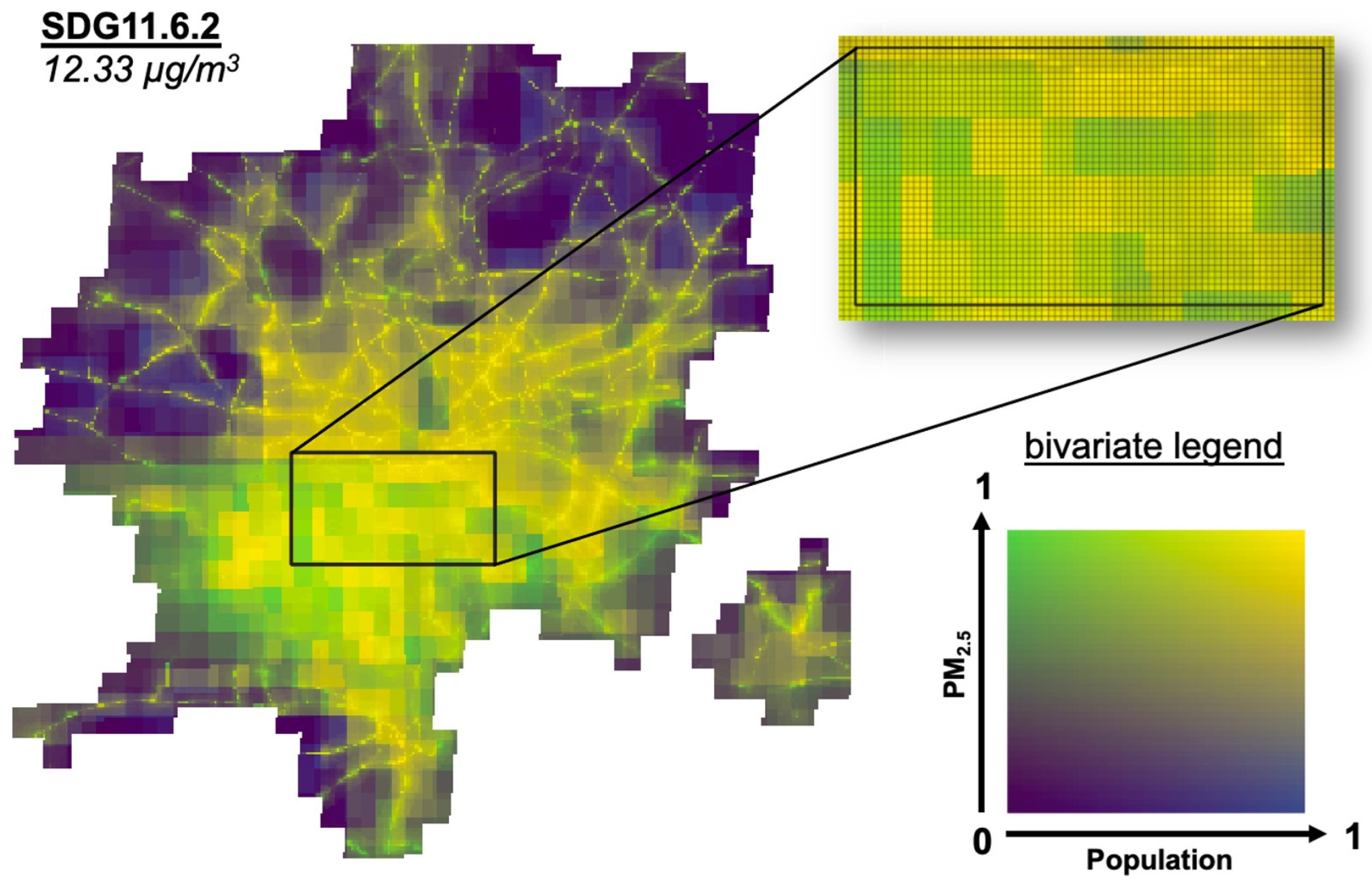

| Limit, Guideline & Targets: | WHO | WHO IT4 | WHO IT3 | EU/WHO IT2 | WHO IT1 | |
|---|---|---|---|---|---|---|
| Country | SD/AVG | 5 μg/m3 | 10 μg/m3 | 15 μg/m3 | 25 μg/m3 | 35 μg/m3 |
| UK | 3.7% | FUA ↓ | ||||
| Denmark | 5.6% | FUA, UC ↓ | ||||
| Spain | 8.2% | UN ↓ | ||||
| Greece | 8.3% | FUA, EuSt ↓ | ||||
| Slovakia | 8.4% | EuSt ↓ | ||||
| Portugal | 11.9% | UN ↓ | ||||
| Cyprus | 16% | UN ↑ | ||||
| Bulgaria | 19.7% | FUA ↓ | ||||
| Latvia | 26.6% | FUA ↓ | EuSt ↑ | |||
| Iceland | 30.9% | UN ↑ | ||||
| Malta * | 4.7% | UN ↓ | ||||
| North Macedonia * | 16.6% | FUA ↓ | ||||
| Albania * | 19.6% | UN ↑ | ||||
| Bosnia and Herzegovina * | 30.8% | UN ↑ | ||||
| Montenegro * | 32.9% | UN ↑ | ||||
| Turkey * | 57.8% | UN ↑ | UN ↑ | |||
| 0–5% | Belgium, Austria, Netherlands, Germany, France | Hungary *, Malta * | |||||
| 5–10% | Romania, Czechia, Poland, Sweden, Italy | Lithuania * | |||||
| 10–15% | Finland, Luxembourg, Switzerland, Estonia, Slovenia, Croatia | Serbia * | |||||
| >15% | Ireland, Norway | |||||
Disclaimer/Publisher’s Note: The statements, opinions and data contained in all publications are solely those of the individual author(s) and contributor(s) and not of MDPI and/or the editor(s). MDPI and/or the editor(s) disclaim responsibility for any injury to people or property resulting from any ideas, methods, instructions or products referred to in the content. |
© 2023 by the authors. Licensee MDPI, Basel, Switzerland. This article is an open access article distributed under the terms and conditions of the Creative Commons Attribution (CC BY) license (https://creativecommons.org/licenses/by/4.0/).
Share and Cite
Bailey, J.; Ramacher, M.O.P.; Speyer, O.; Athanasopoulou, E.; Karl, M.; Gerasopoulos, E. Localizing SDG 11.6.2 via Earth Observation, Modelling Applications, and Harmonised City Definitions: Policy Implications on Addressing Air Pollution. Remote Sens. 2023, 15, 1082. https://doi.org/10.3390/rs15041082
Bailey J, Ramacher MOP, Speyer O, Athanasopoulou E, Karl M, Gerasopoulos E. Localizing SDG 11.6.2 via Earth Observation, Modelling Applications, and Harmonised City Definitions: Policy Implications on Addressing Air Pollution. Remote Sensing. 2023; 15(4):1082. https://doi.org/10.3390/rs15041082
Chicago/Turabian StyleBailey, Jennifer, Martin Otto Paul Ramacher, Orestis Speyer, Eleni Athanasopoulou, Matthias Karl, and Evangelos Gerasopoulos. 2023. "Localizing SDG 11.6.2 via Earth Observation, Modelling Applications, and Harmonised City Definitions: Policy Implications on Addressing Air Pollution" Remote Sensing 15, no. 4: 1082. https://doi.org/10.3390/rs15041082
APA StyleBailey, J., Ramacher, M. O. P., Speyer, O., Athanasopoulou, E., Karl, M., & Gerasopoulos, E. (2023). Localizing SDG 11.6.2 via Earth Observation, Modelling Applications, and Harmonised City Definitions: Policy Implications on Addressing Air Pollution. Remote Sensing, 15(4), 1082. https://doi.org/10.3390/rs15041082







